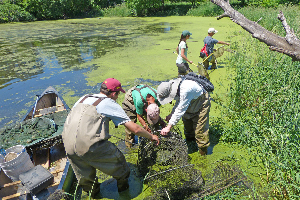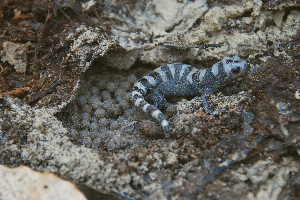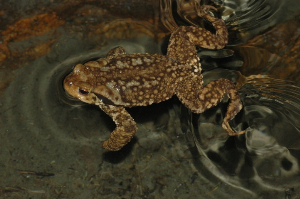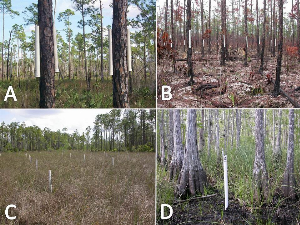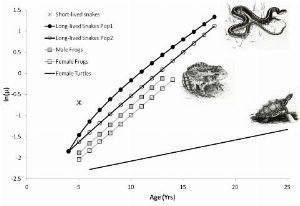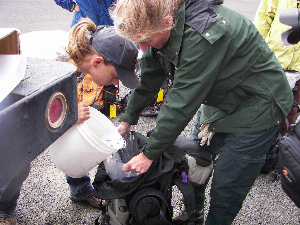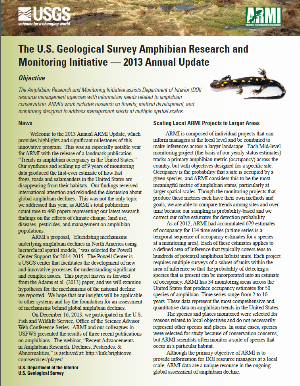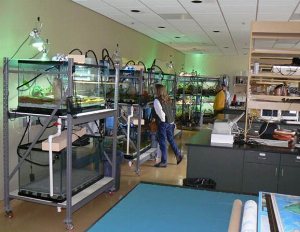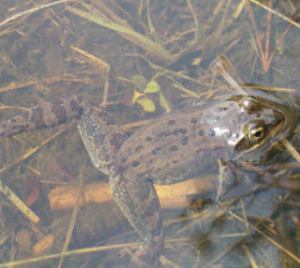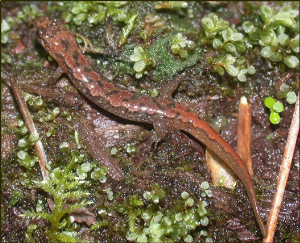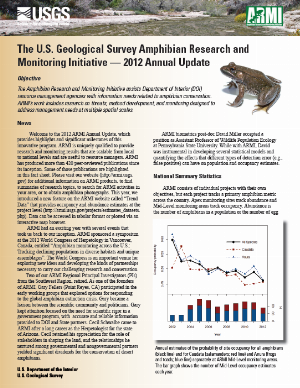Search ARMI Database
Search term(s)
Contribution Number
Search Results
879 record(s) found.
Papers & Reports Pesticide concentrations in frog tissue and wetland habitats in a landscape dominated by agriculture
Authors: Kelly L Smalling; Rebecca A Reeves; Erin Muths; M Vandever; William A Battaglin; Michelle L Hladik; Clay L Pierce
Date: 2014 | Outlet: Science of the Total Environment
Among the multiple stressors potentially affecting the presence of amphibians across agricultural landscapes, habitat loss and exposure to pesticides are likely primary factors contributing to amphibian decline. Conservation efforts have attempted to restore wetlands lost through landscape modifications with the aim of reducing contaminant loads in surface waters and providing quality habitat to wildlife. However, the benefits of this increased wetland area, perhaps especially for amphibians, may be negated if habitat quality is insufficient to support persistent populations. We examined the presence of pesticides and nutrients in water and sediment as indicators of habitat quality and assessed the accumulation of pesticides in tissue of two native amphibian species Pseudacris maculata (chorus frogs) and Lithobates pipiens (leopard frogs) at six wetlands (3 restored and 3 reference) in Iowa, USA. Restored wetlands are positioned on the landscape to receive subsurface tile drainage water while reference wetlands receive water from overland run-off and shallow groundwater sources. Concentrations of the pesticides frequently detected in water and sediment samples were not different between wetland types. The herbicide atrazine was detected in 100% of the water samples and in some instances at concentrations high enough to potentially cause reproductive effects in leopard frogs. Nutrient concentrations were higher in the restored wetlands but lower than concentrations thought to cause lethality in frogs. Seventeen pesticides were detected in tissue samples with concentrations ranging from https://0.08 to 1,500 µg/kg wet weight. No significant differences in pesticide concentrations were observed between species, although concentrations tended to be higher in leopard frogs compared to chorus frogs, possibly because of differences in life histories. Our results provide information on habitat quality in restored wetlands that will assist state and federal agencies, landowners, and resource managers in identifying and implementing conservation and management actions for these and similar wetlands in agriculturally dominated landscapes.
Papers & Reports Reproductive biology of Ambystoma salamanders in the southeastern United States
Authors: Brad M Glorioso; Hardin J Waddle; J M Hefner
Date: 2015-06-16 | Outlet: Herpetology Notes 8:347-356
Reproductive aspects of Ambystoma salamanders were investigated at a site in Louisiana (2010–2012) and a site in Mississippi (2013). Three species occurred at the Louisiana site, Spotted Salamander (A. maculatum), Marbled Salamander (A. opacum), and Mole Salamander (A. talpoideum), whereas only Spotted Salamanders were studied at the Mississippi site. A total of 162 and 71 egg masses of Spotted Salamanders were examined at the Louisiana and Mississippi sites, respectively. Significantly more Spotted Salamander eggs per mass were observed at the Mississippi site (78.2) than the Louisiana site (53.8; p<0.001). The mean snout-vent length of female Spotted Salamanders at the Mississippi site (82.9 mm) was significantly larger than the Louisiana site (76.1 mm; p<0.001). Opaque Spotted Salamander egg masses were not found at the Mississippi site, but accounted for 11% of examined egg masses at the Louisiana site. The mean number of eggs per mass at the Louisiana site did not differ between opaque (47.3) and clear (54.6) egg masses (p=0.21). A total of 47 egg masses of the Mole Salamander were examined, with a mean number of 6.7 embryos per mass. Twenty-three individual nests of the Marbled Salamander were found either under or in decaying logs in the dry pond basins. There was no difference between the mean numbers of eggs per mass of attended nests (93.0) versus those that were discovered unattended (86.6; p=0.67). Females tended to place their nests at intermediate heights within the pond basin.
Papers & Reports Identifying monitoring gaps for amphibian populations in a North American biodiversity hotspot, the southeastern USA
Authors: Susan C Walls
Date: 2014-09-10 | Outlet: Biodiversity and Conservation 23(13):3341-3357.
I review the primary literature to ascertain the status of amphibian monitoring efforts in the southeastern USA, a “hotspot” for biodiversity in North America. This effort revealed taxonomic, geographic and ecological disparities in studies of amphibian populations in this region. Of the species of anurans and caudates known to occur in the Southeast, 73.8% and 33.3%, respectively, have been monitored continuously for at least 4 years. Anurans are generally shorter-lived than are caudates and, thus, have been studied for the equivalent of at least one population turnover more than have caudates. The percentage of species (of those occurring in a given state) monitored continuously for at least 4 years was lowest for Alabama and Mississippi and highest for Florida for both taxa. The vast majority of studies (69.6%) were conducted on species that inhabit natural freshwater wetlands, in contrast to other aquatic and terrestrial habitats. Species considered threatened by the International Union for Conservation of Nature (IUCN) comprised only 7.7% of 65 species that have been studied consistently. The majority of comparative studies of contemporary vs. historical occurrences were potentially biased by the use of “presence-only” historical data and resurveys of short duration. Other issues, such as inadequate temporal and spatial scale and neglect of different sources of error, were common. Awareness of these data gaps and sampling and statistical issues may help facilitate informed decisions in setting future monitoring priorities, particularly with respect to species, habitats and locations that have been largely overlooked in past and ongoing studies.
Papers & Reports Please don’t misuse the museum: ‘declines’ may be statistical
Authors: Evan HC Grant
Outlet: Global Change Biology
Detecting declines in populations at broad spatial scales takes enormous effort, and long-term data are often more sparse than is desired for estimating trends, identifying drivers for population changes, framing conservation decisions or taking management actions. Museum records and historic data can be available at large scales across multiple decades, and are therefore an attractive source of information on the comparative status of populations. However, changes in populations may be real (e.g., in response to environmental covariates) or resulting from variation in our ability to observe the true population response (also possibly related to environmental covariates). Evaluating statistical hypotheses alongside more interesting ecological ones is important in the appropriate use of museum data. Two statistical considerations are generally applicable to use of museum records; first without initial random sampling, comparison with contemporary results cannot provide inference to the entire range of a species, and second the availability of only some individuals in a population may respond to environmental changes. Changes in the availability of individuals may reduce the proportion of the population that is available to be counted on a given survey event, resulting in an apparent decline even when population size is stable.
Papers & Reports Heterogeneous occupancy and density estimates of the pathogenic fungus Batrachochytrium dendrobatidis in waters of North America
Authors: T Chestnut; Chauncey W Anderson; R Popa; M A Voytek; Andrew R Blaustein; Deanna H Olson; Julie A Kirshtein
Date: 2014 | Outlet: PLOS One 9(9): e106790
Biodiversity losses are occurring worldwide due to a combination of stressors. For example, one estimate is that 40% of amphibian species are vulnerable to extinction and a major contributing factor to losses in amphibian biodiversity in disease. One pathogen, the emerging infectious fungus Batrachochytrium dendrobatidis (Bd) is a contributor to amphibian population declines worldwide. Bd research has focused on the dynamicas of the pathogen within amphibian hosts with little emphasis on investigating the potential dynamics of free-living Bd. Therefore, we investigated patterns of Bd occupancy and density in amphibian habitats using occupancy models, powerful tools for estimating site occupancy and detection probability. Occupancy models have been used to investigate diseases where the focus was on pathogen occurrence in the host. We applied occupancy models to investigate free-living Bd in North American surface waters to determine Bd seasonality, relationships between Bd site occupancy and habitat attributes, and probability of Bd detection from water samples as a function of the number of samples, sample volume, and water quality. We also report on the temporal patterns of Bd density from a 4-year case study of a Bd-positive wetland. We provide evidence that Bd occurs in the environment year-round. Bd exhibited temporal and spatial heterogeneity in density, but did not exhibit seasonality in occupancy. Bd was detected in all months, typically less than 100 zoospores L-1. The highest density observed was ~3 million zoospores L-1. We detected Bd in 47% of sites sampled but estimated Bd occupied 61% of sites, highlighting the importance of accounting for imperfect detection. When Bd was present, there was a 95% chance of detecting it with four samples of 600 ml of water or five samples of 60 ml. Our findings provide important baseline information to advance the study of Bd disease ecology in temperate-zone systems, and advance our understanding of amphibian exposure to free-living Bd in aquatic habitats over time.
Papers & Reports Demography of common toads after local extirpation of
Authors: Jaime Bosch; S Fernandez-Beaskoetxez; R D Scherer; Staci M Amburgey; Erin Muths
Date: 2014-09 | Outlet: Amphibia-Reptilia
Estimating demographic parameters like survival or recruitment provides insight into the state and trajectory of populations, but understanding the contexts influencing those parameters, including both biotic and abiotic factors, is particularly important for management and conservation. At a high elevation national park in Central Spain, common toads (Bufo bufo) are apparently taking advantage of the near-extirpation of the midwife toad (Alytes obstetricans), as colonizationinto new breeding ponds is evident.Within this scenario, we expected demographic parameters of common toad populations to be affected favorably by the putative release from competition. However, we found the population growth rate was negative in 4 of 5 years at the long-standing population; survival probability at the long-standing population and newly-colonized breeding ponds was lower than reported for other toads living at high elevations and the probability of recruitment was inadequate to compensate for the survival rate in maintaining a positive trajectory for either of the breeding ponds. We assessed weather covariates and disease for their contribution to the context thatmay be limiting the common toad’s successful use of the niche vacated by the midwife toad.
Papers & Reports Partitioning the non-consumptive effects of predators on prey with complex life histories
Authors: M Davenport; Blake R Hossack; W H Lowe
Date: 2014-08 | Outlet: Oecologia 176:149–155
Non-consumptive effects (NCE) of predators on prey can be as strong as consumptive effects and may be driven by numerous mechanisms, including predator characteristics. Previous work has highlighted the importance of predator characteristics in predicting NCEs, but has not addressed how complex life histories of prey could mediate predator NCEs. We conducted a meta-analysis to compare the effects of predator gape limitation (gape-limited or not) and hunting mode (active or sit-and-pursue) on the activity, larval period, and size at metamorphosis on larval aquatic amphibians and invertebrates. Larval prey tended to reduce their activity and require more time to reach metamorphosis in the presence of all predator functional groups, but the responses did not differ from zero. Prey metamorphosed at smaller size in response to non-gape-limited, active predators, but counter to expectations, prey metamorphosed larger when confronted by non-gape-limited, sit-and-pursue predators. These results indicate NCEs on larval prey life history can be strongly influenced by predator functional characteristics. More broadly, our results suggest that understanding predator NCEs would benefit from greater consideration of how prey life-history attributes mediate population and community-level outcomes.
Papers & Reports Assessing the efficacy of environmental DNA for detecting presence of imperiled aquatic amphibian species in isolated wetland in the Southeastern US.
Authors: Anna M McKee; Daniel L Calhoun; William J Barichivich; S F Spear; Caren S Goldberg; T C Glenn
Date: 2015-12 | Outlet: Journal of Fish and Wildlife Management 6(2):498-510.
Environmental DNA (eDNA) is an emerging tool that allows low-impact sampling for aquatic species by isolating DNA from water samples and screening for DNA sequences specific to species of interest. However, researchers have not tested this method in naturally acidic wetlands that provide breeding habitat for a number of imperiled species, including the frosted salamander (Ambystoma cingulatum), reticulated flatwoods salamanders (Ambystoma bishopi), striped newt (Notophthalmus perstriatus), and gopher frog (Lithobates capito). Our objectives for this study were to develop and optimize eDNA survey protocols and assays to complement and enhance capture-based survey methods for these amphibian species. We collected three or more water samples, dipnetted or trapped larval and adult amphibians, and conducted visual encounter surveys for egg masses for target species at 40 sites on 12 different longleaf pine (Pinus palustris) tracts. We used quantitative PCRs to screen eDNA from each site for target species presence. We detected flatwoods salamanders at three sites with eDNA but did not detect them during physical surveys. Based on the sample location we assumed these eDNA detections to indicate the presence of frosted flatwoods salamanders. We did not detect reticulated flatwoods salamanders. We detected striped newts with physical and eDNA surveys at two wetlands. We detected gopher frogs at 12 sites total, three with eDNA alone, two with physical surveys alone, and seven with physical and eDNA surveys. We detected our target species with eDNA at 9 of 11 sites where they were present as indicated from traditional surveys and at six sites where they were not detected with traditional surveys. It was, however, critical to use at least three water samples per site for eDNA. Our results demonstrate eDNA surveys can be a useful complement to traditional survey methods for detecting imperiled pond-breeding amphibians. Environmental DNA may be particularly useful in situations where detection probability using traditional survey methods is low or access by trained personnel is limited.
Papers & Reports Detection of the emerging amphibian pathogens Batrachochytrium dendrobatidis and Ranavirus in Russian amphibians
Authors: A N Reshetnikov; T Chestnut; Jesse L Brunner; K Charles; E E Nebergall; Deanna H Olson
Date: 2014-08 | Outlet: Diseases of Aquatic Organisms 110:235-240
In a population of the European common toad Bufo bufo from a rural pond in the region of Lake Glubokoe Regional Reserve in Moscow province, Russia, unexplained mass mortality events involving larvae and metamorphs were observed in several years. We tested toads from this and a nearby site for the emerging amphibian pathogens Batrachochytrium dendrobatidis (Bd) and Ranavirus (Rv). Both pathogens were detected, and at the site with noted losses and declining toad breeding success, 40% of B. bufo metamorphs were Bd positive, 46% were Rv positive; 20% were co-infected with the both pathogens. Toad metamorphs from the neighbouring water body were also Bd and Rv positive (25 and 55% respectively). This is the first confirmation of these pathogens in Russia. Questions remain as to the origins of these pathogens in Russia and their roles in documented mass mortality events.
Papers & Reports A review of pipe and bamboo artificial refugia as a sampling tool in anuran studies
Authors: Brad M Glorioso; Hardin J Waddle
Date: 2014-12-31 | Outlet: Herpetological Conservation and Biology 9:609-625
Artificial pipe-like refugia have been used by researchers for more than 40 years in anuran studies, and captured 28 species, primarily (82%) hylid treefrogs. Early pipe-like refugia were made using cut pieces of bamboo in the tropical forests of Puerto Rico, but more recent studies have used synthetic pipes and have occurred primarily in the southeastern United States. Although some studies have addressed particular aspects of pipe design, the diverse characteristics of the refugia as well as their placement in the environment have varied greatly, making comparisons among studies difficult. Here, we summarize and evaluate information regarding pipe designs and placement, address potential concerns for researchers, and suggest studies necessary to better interpret the data gained from this technique in anuran studies.
Papers & Reports Biodemography of Ectothermic Tetrapods Provides Insights into the Evolution and Plasticity of Mortality Patterns
Authors: David AW Miller; Fredric J Janzen; Gary M Fellers; Patrick M Kleeman; Anne M Bronikowski
Date: 2014 | Outlet: Sociality, Hierarchy, Health: Comparative Biodemography: Papers from a Workshop: 295-313.
In this paper we examine the biodemography of wild populations of three species (a turtle, a frog, and a snake). All are ectotherms, an understudied subset of the vertebrate taxa for understanding aging. Employing a comparative perspective by examining wild populations of relatively long-lived ectothermic vertebrates, we found that (1) across all three species, there was strong evidence for mortality senescence and (2) environmental factors, including stress, influence age-specific patterns of mortality both in current and later years and therefore produces plastic variation in the shapes of mortality trajectories.
Papers & Reports Animal reintroductions: an innovative assessment of survival
Authors: Erin Muths; Larissa L Bailey; Mary K Watry
Date: 2014-06 | Outlet: Biological Conservation xx:xxx-xxx
Quantitative evaluations of reintroductions are infrequent and assessments of milestones reached before a project is completed, or abandoned due to lack of funding, are rare. However, such assessments, which are promoted in adaptive management frameworks, are critical. Quantification can provide defensible estimates of biological success, such as the number of survivors from a released cohort, with associated cost per animal. It is unlikely that the global issues of endangered wildlife and population declines will abate, therefore, assurance colonies and reintroductions are likely to become more common. If such endeavors are to be successful biologically or achieve adequate funding, implementation must be more rigorous and accountable. We use a novel application of a multistate, robust design capture-recapture model to estimate survival of reintroduced tadpoles through metamorphosis (i.e., the number of individuals emerging from the pond) and thereby provide a quantitative measure of effort and success for an “in progress” reintroduction of toads. Our data also suggest that tadpoles released at later developmental stages have an increased probability of survival and that eggs laid in the wild hatched at higher rates than eggs laid by captive toads. We illustrate how an interim assessment can identify problems, highlight successes, and provide information for use in adjusting the effort or implementing a Decision-Theoretic adaptive management strategy.
Papers & Reports ARMI 2013 Annual Update
Authors: Brian J Halstead; Michael J Adams; Evan HC Grant; Blake R Hossack; Kelly L Smalling; Lianne Ball
Date: 2014-02-17
Welcome to the 2013 Annual ARMI Update, which provides highlights and significant milestones of this innovative program. This was an especially notable year for ARMI with the release of a landmark publication “Trends in amphibian occupancy in the United States.” Our synthesis and scaling up of 9 years of monitoring data produced the first-ever estimate of how fast frogs, toads and salamanders in the United States are disappearing from their habitats. Our findings received international attention and rekindled the discussion about global amphibian declines. This was not the only topic we addressed this year, as ARMI’s total publication count rose to 460 papers representing our latest research findings on the effects of climate change, land use, diseases, pesticides, and management on amphibian populations.
Full text: https://armi.usgs.gov/docs/ARMI%202013%20Annual%20Update.pdf
Full text: https://armi.usgs.gov/docs/ARMI%202013%20Annual%20Update.pdf
Papers & Reports Population declines lead to replicate patterns of internal range structure at the tips of the distribution of the California red-legged frog (Rana draytonii)
Authors: Jonathan Q Richmond; Adam R Backlin; Patricia Tatarian; B G Solvesky; Robert N Fisher
Date: 2014 | Outlet: Biological Conservation
Demographic declines and increased isolation of peripheral populations of the threatened California red-legged frog(Rana draytonii)have led to the formation of internal range boundaries at opposite ends of the species’ distribution. While the population genetics of the southern internal boundary has been studied in some detail, similar information is lacking for the northern part of the range. In this study, we used microsatellite and mtDNA data to examine the genetic structuring and diversity of some of the last remaining R. draytonii populations in the northern Sierra Nevada, which collectively form the northern external range boundary. We compared these data to coastal populations in the San Francisco Bay Area, where the species is notably more abundant and still exists throughout much of its historic range. We show that ‘external’ Sierra Nevada populations have lower genetic diversity and are more differentiated from one another than their ‘internal’ Bay Area counterparts. This same pattern was mirrored across the distribution in California, where Sierra Nevada and Bay Area populations had lower allelic variability compared to those previously studied in coastal southern California. This genetic signature of northward range expansion was mirrored in the phylogeography of mtDNA haplotypes; northern Sierra Nevada haplotypes showed greater similarity to haplotypes from the south Coast Ranges than to the more geographically proximate populations in the Bay Area. These data cast new light on the geographic origins of Sierra Nevada R. draytonii populations and highlight the importance of distinguishing the genetic effects of contemporary demographic declines from underlying signatures of historic range expansion when addressing the most immediate threats to population persistence. Because there is no evidence of contemporary gene flow between any of the Sierra Nevada R. draytonii populations, we suggest that management activities should focus on maintaining and creating additional ponds to support breeding within typical dispersal distances of occupied habitat.
Papers & Reports ANAXYRUS BOREAS (Western Toad). PREDATION
Authors: L K Swartz; C R Faurot-Daniels; Blake R Hossack; Erin Muths
Date: 2014 | Outlet: Herpetological Review 45:303
Papers & Reports Chilled Frogs are Hot: Hibernation and Reproduction of the Endangered Mountain Yellow-Legged Frog (Rana muscosa)
Authors: F E Santana; R R Swaisgood; J M Lemm; Robert N Fisher; R W Clark
Date: 2015-02-11 | Outlet: Endangered Species Research 27:43-51
In the face of the sixth great extinction crisis, it is imperative to establish effective breeding protocols for amphibian conservation breeding programs. Efforts should not proceed by trial and error, nor should they jump prematurely to assisted reproduction techniques, which can be invasive, difficult, costly, and, at times, counterproductive. Instead, conservation practitioners should first look to nature for guidance, and replicate key conditions found in nature in the captive environment, according to the ecological and behavioral requirements of the species. We tested the effect of a natural hibernation regime on reproductive behaviors and health in the critically endangered mountain yellow-legged frog (Rana muscosa). Hibernation had a clear effect on reproductive behavior, manifesting in vocal advertisement signaling, female receptivity, amplexus, and oviposition. These behaviors are critical components of courtship that lead to successful reproduction. Our main finding was that R. muscosa requires a hibernation period for successful reproduction as only hibernated females produced eggs and only hibernated males successfully fertilized eggs. Although hibernation also negatively impacted body condition, it did so without any evident declines in frog health. This dependency on hibernation is not surprising since it is a major component of the conditions that R. muscosa experiences in the wild. Similar approaches to test hypotheses based on mimicking natural ecological conditions should be used in other amphibian conservation breeding programs to ensure that captive assurance colonies can play their role as genetic reservoirs for assurance and reintroduction.
Papers & Reports Anuran site occupancy and species richness as tools for evaluating restoration of a hydrologically-modified landscape
Authors: Susan C Walls; Hardin J Waddle; William J Barichivich; Ian A Bartoszek; Mary E Brown; J M Hefner; M J Schuman
Date: 2014-06-14 | Outlet: Wetlands Ecology and Management 22(6)625-639.
A fundamental goal of wetland restoration is to reinstate pre-disturbance hydrological conditions to degraded landscapes, facilitating recolonization by native species and the production of resilient, functional ecosystems. To evaluate restoration success, baseline conditions need to be determined and a reference target needs to be established that will serve as an ecological blueprint in the restoration process. During the summer wet seasons of 2010 and 2011, we used automated recording units to monitor a community of calling anuran amphibians in the Picayune Strand State Forest of southwest Florida, USA. This area is undergoing hydrological restoration as part of the Comprehensive Everglades Restoration Plan (CERP). We compared occurrence of anurans at sites in the restoration area, to nearby sites in relatively undisturbed habitat. We assessed the utility of the latter as restoration targets, using a hierarchical model of community species occupancy to estimate the probability of occurrence of anurans in restoration and reference locations. We detected 14 species, 13 of which were significantly more likely to occur in reference areas. All 14 species were estimated by our model to occur at these sites but, across both years, only 8–13 species were estimated to occur at restoration sites. The composition and structure of these habitats within and adjacent to the Picayune Strand State Forest indicate that they are suitable targets for habitat restoration, as measured by amphibian occurrence and species richness. These areas are important sources for recolonization of anuran amphibians as the hydrologically degraded Picayune Strand undergoes restoration to mitigate the effects of overdrainage and habitat loss.
Papers & Reports Breeding site heterogeneity reduces variability in frog recruitment and population dynamics
Authors: Rebecca M McCaffery; Lisa A Eby; B A Maxell; P. Stephen Corn
Date: 2014 | Outlet: Biological Conservation 170:169-176
Environmental stochasticity can have profound effects on the dynamics and viability of wild populations, and habitat heterogeneity provides one mechanism by which populations may be buffered against the negative effects of environmental fluctuations. Heterogeneity in breeding pond hydroperiod across the landscape may allow amphibian populations to persist despite variable interannual precipitation. We examined recruitment dynamics over 10 yr in a high elevation Columbia spotted frog (Rana luteiventris) population that breeds in ponds with a variety of hydroperiods. We combined these data with matrix population models to quantify the consequences of heterogeneity in pond hydroperiod on net recruitment (i.e. number of metamorphs produced) and population growth rates. We compared our heterogeneous system to hypothetical homogeneous environments with (1) only ephemeral ponds, (2) only semi-permanent ponds, and (3) only permanent ponds. We also examined the effect of breeding pond habitat loss on population growth rates. Most eggs were laid in permanent ponds each year, but survival to metamorphosis was highest in the semi-permanent ponds. Recruitment success varied by both year and pond type. Net recruitment and stochastic population growth rate were highest under a scenario with homogeneous semi-permanent ponds, but variability in recruitment was lowest in the scenario with the observed heterogeneity in hydroperiods. Loss of pond habitat decreased population growth rate, with greater decreases associated with loss of permanent and semi-permanent habitat. The presence of a diversity of pond hydroperiods on the landscape will influence population dynamics, including reducing variability in recruitment in an uncertain climatic future.
Papers & Reports Modeling structured population dynamics using data from unmarked individuals
Authors: E F Zipkin; J T Thorson; K See; H J Lynch; Evan HC Grant; Y Kanno; Richard Chandler; B H Letcher; J A Royle
Outlet: Ecology
The study of population dynamics requires unbiased, precise estimates of
abundance and vital rates that account for the demographic structure inherent in all wildlife
and plant populations. Traditionally, these estimates have only been available through
approaches that rely on intensive capture–recapture data. We extended recently developed Nmixture
models to demonstrate how demographic parameters and abundance can be estimated
for structured populations using only stage-structured count data. Our modeling framework
can be used to make reliable inferences on abundance as well as recruitment, immigration,
stage-specific survival, and detection rates during sampling. We present a range of simulations
to illustrate the data requirements, including the number of years and locations necessary for
accurate and precise parameter estimates. We apply our modeling framework to a population
of northern dusky salamanders (Desmognathus fuscus) in the mid-Atlantic region (USA) and
find that the population is unexpectedly declining. Our approach represents a valuable
advance in the estimation of population dynamics using multistate data from unmarked
individuals and should additionally be useful in the development of integrated models that
combine data from intensive (e.g., capture–recapture) and extensive (e.g., counts) data
sources.
abundance and vital rates that account for the demographic structure inherent in all wildlife
and plant populations. Traditionally, these estimates have only been available through
approaches that rely on intensive capture–recapture data. We extended recently developed Nmixture
models to demonstrate how demographic parameters and abundance can be estimated
for structured populations using only stage-structured count data. Our modeling framework
can be used to make reliable inferences on abundance as well as recruitment, immigration,
stage-specific survival, and detection rates during sampling. We present a range of simulations
to illustrate the data requirements, including the number of years and locations necessary for
accurate and precise parameter estimates. We apply our modeling framework to a population
of northern dusky salamanders (Desmognathus fuscus) in the mid-Atlantic region (USA) and
find that the population is unexpectedly declining. Our approach represents a valuable
advance in the estimation of population dynamics using multistate data from unmarked
individuals and should additionally be useful in the development of integrated models that
combine data from intensive (e.g., capture–recapture) and extensive (e.g., counts) data
sources.
Papers & Reports ARMI 2012 Annual Update
Authors: Blake R Hossack; Michael J Adams; Hardin J Waddle; Evan HC Grant; Robert N Fisher; William A Battaglin; Lianne Ball
Welcome to the 2012 ARMI Annual Update, which provides highlights and significant milestones of this innovative program. ARMI is uniquely qualified to provide research and monitoring results that are scalable from local to national levels and are useful to resource managers. ARMI has produced more than 420 peer-reviewed publications since its inception. Some of those publications are highlighted in this fact sheet. Please visit our website (http://armi.usgs.gov) for additional information on ARMI products, to find summaries of research topics, to search for ARMI activities in your area, or to obtain amphibian photographs. This year, we introduced a new feature on the ARMI website called “Trend Data” that provides occupancy and abundance estimates at the project level (http://armi.usgs.gov/projects/estimates_datasets.php). Data can be accessed in tabular format or plotted via an interactive map.
Full text: http://armi.usgs.gov/docs/ARMI%202012%20Annual%20Update.pdf
Full text: http://armi.usgs.gov/docs/ARMI%202012%20Annual%20Update.pdf

